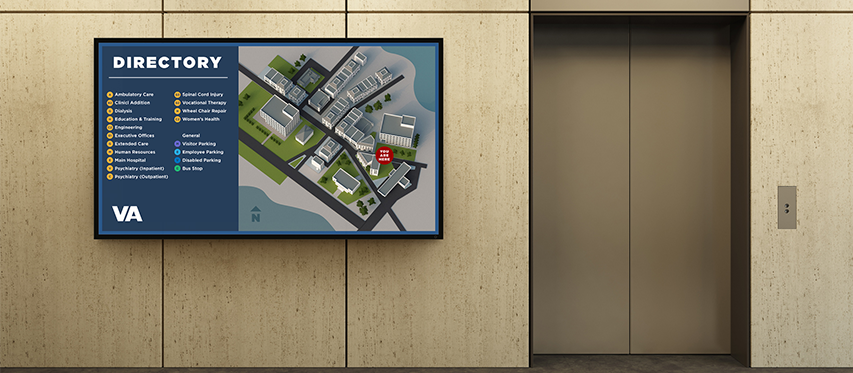VA Hospitals Target and Engage in More Ways Thanks to Digital Signage

For 10 years, the U.S. Department of Veterans Affairs (VA) has leveraged HughesON™ Digital Signage solutions at VA hospitals and clinics around the country, taking advantage of its many benefits as a fully managed, turnkey offering. Employing the powerful capabilities of digital signage, the VA has integrated their communications strategies and channels to deliver timely information wherever and whenever it’s needed. As a result, the VA has replaced posters, pamphlets, and notices previously displayed throughout lobbies and public areas with far more dynamic and media-rich dissemination, while also complying with the Federal Government’s mandate to reduce paper consumption. In the touchless era of COVID precautions, the signage has taken on even more importance.
Over the last few years, Hughes has incorporated SmartTVs into the solution, so there is no longer a need to rely on individual media players. Most recently, Hughes engineers have completed a sizable technology upgrade, developing a solution to securely store content in a single on-premise server, rather than in the Cloud. Each SmartTV on the hospital’s network connects to this on-premise server. A user-friendly interface make is easy for the VA staff to schedule and manage content.
“On prem servers are a state-of-the art approach for taking advantage of the SmartTV option. Plus, a single piece of hardware reduces the risk of failure associated with having multiple components. Overall, it’s more cost-effective, because it’s easier to maintain and troubleshoot,” said Rick Whiteside, principal engineer at Hughes.
The Power of Targeted Content
While all of the hospital networks belong to the massive VA system, they operate independently of one another. The Hughes solution delivers tremendous flexibility in how each can use digital content to meet a range of visitor, patient, and staff needs.
“It’s not uncommon in hospital and clinic settings for signage to consist of propped-up easels and poster boards,” explained Amir Dehdashty, senior director at Hughes. “By having Digital Signage to support dynamic content, they can communicate in more engaging ways. Plus, they can change the information daily, weekly, and monthly.”
In one hospital, for example, after many years of having Digital Signage deployed throughout its facilities, the VA hospital network deployed 76 new monitors — one at every nursing station in the hospital.
“This hospital is the first to use signage in this way and to focus on nursing-specific content, such as training and job-specific notices, with their nursing organization managing the content. It’s the same server, but content doesn’t mix with other content from the Public Affairs Office,” Mr. Dehdashty said.
Another new feature associated with the on-premise server is the ability to disseminate targeted emergency notifications.
“If it’s some type of man-made threat or disturbance, like an active shooter, the security staff can immediately take over the system and put out emergency notifications on all monitors,” Mr. Dehdashty said. “The signage enables them to communicate with urgency. They may have a monitor on the fifth floor and need to tell that floor’s staff to go hide in the closet, whereas in the lobby, the message might be to vacate the building.”
In another example, where VA facilities are in a state with frequent tornados, the signage monitors located in the western part of the state may need to display storm or tornado warnings, while those in the eastern part of the state may not need to receive such messages.
At campuses with pharmacies, facilities use monitors to display when prescription notifications are ready for patient pick-up. In cafeterias, they display daily menus.
“We even heard that one large campus with bus service to various buildings uses lobby signage to show bus schedules and when the next bus is expected to arrive. Buses are outfitted with wireless technology and tracking that connects to the signage system, so staff and visitors get real-time information,” Mr. Dehdashty added.
HughesON Digital Signage is currently in place at VA hospitals in 10 states, as well as at more than 200 affiliated community-based outpatient clinics. Based on location requirements, the Hughes solution includes end-to-end system design, installation, training, operations, help desk, and on-site maintenance. With so many unique deployments, Hughes has implemented a host of creative ways to engage and inform as we put Digital Signage to work.
For more information about HughesON Digital Signage, please click here.